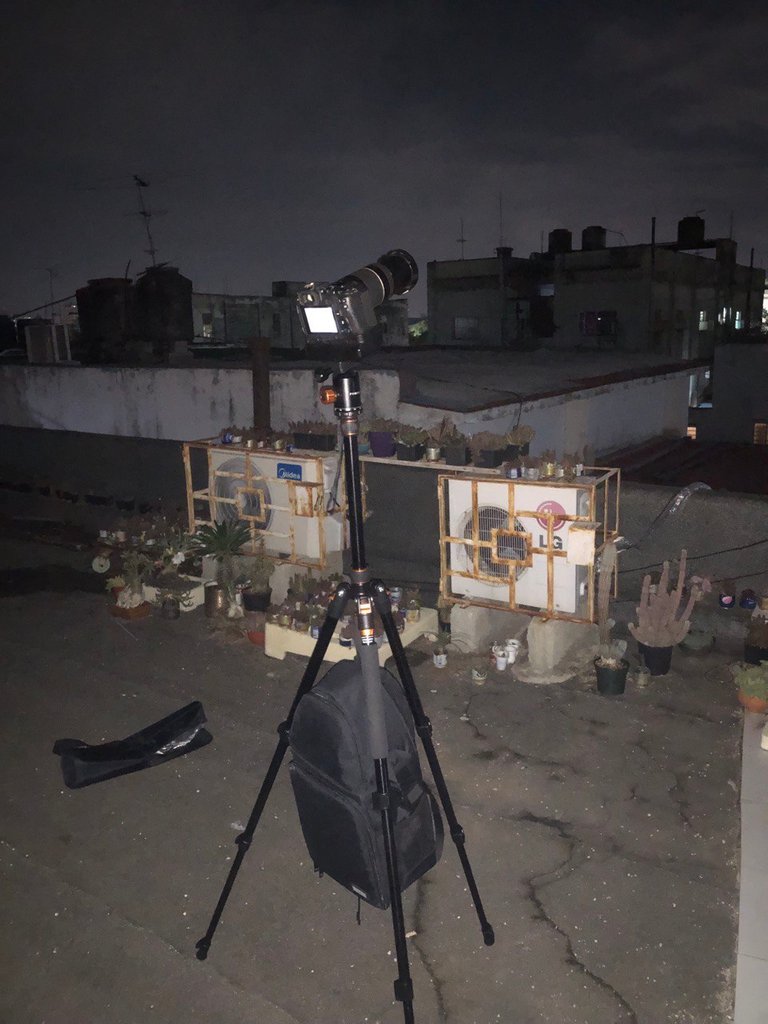Perhaps most of you have heard about the lunar eclipse that occurred last night and early this morning. As a photographer and as part of my most recent job for a news magazine I set out last night to capture the moon and its eclipse in the different stages that occur during this event. So I went up to the roof armed with my Canon RP, a Canon 70-300mm lens owned by my brother-in-law @karelnt, my tripod which is a vital tool and my phone which I would use as a shooter thanks to the Canon Camera Connect app.
Quizás la mayoría se hayan enterado del eclipse lunar que ocurrió ayer en la noche y madrugada de hoy. Como fotógrafo y como parte de mi mas reciente trabajo para una revista informativa me dispuse ayer en horas de la noche a capturar la luna y su eclipse en las distintas etapas que transcurren durante este suceso. Así que subí hasta la azotea armada con mi Canon RP, un lente Canon 70-300mm que es propiedad de mi cuñado @karelnt, mi trípode que es una herramienta vital y mi teléfono que usaría como disparar gracias a la app Canon Camera Connect.

There was only one problem, the large amount of clouds that almost did not allow me to take a decent picture of the moon and then did not let me complete the photos of each phase, as you will see I could only manage to take one of the beginning of the eclipse. If you don't know how to take pictures like this let me tell you that there are many good tutorials that you can google, but I will give you some quick basic notes. The first thing is to have a telephoto lens with a length of 300mm or more, in my case it was only 300mm and then I had to crop the image a bit. The second thing is to always have a tripod handy, if you don't have one, look for a surface or set it up where the camera can shoot without moving. Which brings us to the third point and that is to use a remote shutter release or shoot with a delay of 2 seconds, in my case I used the Canon app as a shutter release. The last thing would be the parameters, the moon although you may not believe it moves and very fast, so you must have a shutter speed of 1/125 or higher. For a good focus the aperture should be around f.10 and the ISO should be as low as possible, in my case it was 100. I leave you with yesterday's results.
Solo hubo un problema, la gran cantidad de nubes que casi no me permitían hacer una foto decente de la luna y que luego no me dejaron completar las fotos de cada fase, como verán solo puede lograr hacer una del comienzo del eclipse. Si no sabes como puedes hacer fotografías así déjame decirte que hay muchos tutoriales muy buenos que puedes googlear, pero te dará unas anotaciones básicas bien rápidas. Lo primero es tener un lente tele de una longitud de 300mm o mayor, en mi caso fueron solo 300mm y luego tuve que recortar un poco la imagen. Lo segundo es tener siempre un trípode a mano, de no tenerlo busca una superficie o créala donde la cámara pueda disparar sin moverse. Lo que nos lleva al tercer punto y es que uses un disparador remoto o dispares con un retraso de 2 segundos, en mi caso use la app de Canon como disparador. Lo último serían los parámetros, la luna aunque no lo creas se mueve y bien rápido, por lo que debes tener una velocidad de obturación de 1/125 o mayor. Para un buen enfoque el diafragma debe rondar los f.10 y la el ISO debe estar lo mas bajo posible, en mi caso fue de 100. Los dejo con los resultados de ayer.


I hope you liked them and I would like to know if you managed to take any pictures of the moon yesterday. I would like to see if anyone was able to capture the red color that occurs in these cases when the eclipse is at totality.
Espero que les hayan gustado y me gustaría saber si lograron hacer alguna foto ayer a la luna. Me gustaría ver que alguien pudo capturar el color rojo que ocurre en estos casos cuando el eclipse esta en su totalidad.
The rewards earned on this comment will go directly to the person sharing the post on Twitter as long as they are registered with @poshtoken. Sign up at https://hiveposh.com.
Or anyone can do it with at least 28x zoom camera. Sure the picture won't come out that clear but it does the job if they're just starting out.Settings wise, those are good ones but I normally go with ISO 80.
That’s right but i haven’t used a camera with a 24x, in that case a Xiaomi phone with a 100x camera could be use for that. In the iso, my camera only have until 100, which one do you have?
Never tested a xiaomi, so idk. I have a sony dsch-300 it's definitely not as good as with telephoto lens but it's quite decent. This below was taken an hour ago.
It’s, great work
Estuvo complicado de lograr. Hice el intento pero después de infinitas configuraciones para capturar la luna y su sombra roja no obtuve más que un mar de ruido.
Pero usaste trípode?
Seguro!!! Esa parte oscura rojiza era la muy complicada de lograr y era, en definitiva, lo que tenía de bonito el fenómeno. Cuando salí ya iba de salida, o sea, ya se estaba viendo un filo de la luna blanca normal, pero con un brillo violento. En fin, misión imposible para una simple 1200D.